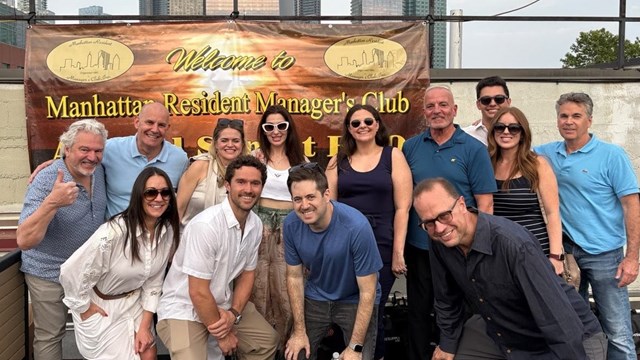
Start thinking of the ideal places to live in the city and there's a good chance that the Upper West Side will come to mind pretty quickly. It's generally thought of as one of the most desirable neighborhoods in Manhattan, thanks to its quality of life, schools, scenic beauty and recreation.
But none of this means that serving the people and businesses of the area is easy - as the members of Community Board 7 know. CB7 covers the Upper West Side from 59th Street to 110th Street from Central Park West to the Hudson River. According to the 2000 Census, it's the third-most populous community board in Manhattan, with around 210,000 people living in its 2.1 square miles.
Serving the Upper West Side
CB7's job, like any other community board, is to serve its community, its residents and its businesses. With so many people to serve, CB7 finds itself tackling countless issues and facing the conundrum of balancing change and development with concerns of over-development. In the case of CB7, this issue is of particular interest considering the history and architecture of the area - and preserving the character of the area is of utmost importance to the community.
According to CB7 chairperson Hope Cohen, despite its large population, the area that CB7 represents is a close-knit community. A community board has to face issues, large and small. The proposed closing of the 72nd Street ramp off the West Side Highway to accommodate new development is something that could affect all residents and has brought Upper West Siders out in droves to board meetings following the announcement of the intended closing. On a smaller scale, changes to an old church are resonating more closely with residents in the church's immediate area. Regardless of the size or scope of the issues, CB7 is dedicated to making the Upper West Side neighborhood a better place to live.
"We're trying to make the neighborhood serve its residents and businesses the best we can," Cohen says. "Our role is to understand the needs of our community, to communicate those needs within the community and most notably to government agencies and to try to get those needs met."
Recreation, Affordable Housing, Over-Development
Among the most important issues for Cohen - one that displays CB7's concern for residents - is affordable housing. "There's a significant senior population in our district and the question of them getting priced out of their housing is a concern [that] we're trying to figure out how to deal with," Cohen says. "We don't have all that much room to develop new affordable housing, so we need to retain what we have."
During a recent interview, Cohen spoke at length about CB7 - the important issues facing the Upper West Side, the board's goals, it's past achievements and her hopes for the future.
What challenges are facing CB7 right now?
"There are citywide concerns, and local things that are coming up. Something that could have an effect on us is the possible reform of community facility zoning [law] which is being proposed by the department of state planning and Councilman Tony Avella of Queens - with a focus on Queens-type issues and not Manhattan-type issues.
"We've been seeing - as other neighborhoods in Manhattan have as well - community facilities - particularly private schools and religious institutions - needing to grow and expand. Certainly if they're landmarks, or in landmark districts, neighbors are quite concerned about growing modern community facilities. [One] example is the West Park Presbyterian Church at Amsterdam and 86th Street. [The church] is not a landmark, and is involved in a real estate deal which would result in the church being destroyed [and a] tower being built with a new church in it. There was an article in the Times about how the residents of one of the neighboring buildings - a co-op - decided to increase their own maintenance in order to make a contribution to the church to convince the church that they can rehabilitate their current space and not have to sell the property and be part of the larger development.
"[Another] hot item currently is the question of closing the 72nd Street exit ramp from the West Side Highway [in order to facilitate the development of Riverside South, a Hudson Waterfront Associates (HWA)/Trump New World development going up between West 71st and 72nd Streets - Ed.]. The committee has disapproved it unanimously and disagrees with the DOT's decision, but it has not yet come before the full board. I expect we haven't heard the last of that.
"We also have longstanding issues of a lack of support services for our special needs population and temporary housing for our homeless. Fully supportive services is something we've been asking for, and we have some very good examples, but we also have some problem areas that present an ongoing concern.
"The possible Lincoln Center development change at 65th Street is a major project that's still in its planning stages. We saw very early plans a couple of years ago, and we're still waiting to see [newer] plans which we understand will be available soon. Obviously, that would change the face of the neighborhood around 65th Street.
"The 59th Street Recreation Center has been of interest to the board for a number of years. The property is owned by the Department of Parks and Recreation and has long been in poor repair. Basically, year after year, the Parks Department tries to get $50,000 here and $100,000 there to plug this plumbing leak and fix that heating problem and stop the ceiling from falling. [In addition to] that, the Rec Center's pool is where lifeguard training for the entire city of New York takes place. Even though it's a community pool, for a number of months each spring, it becomes unavailable to the community [because of] the training. And that's been an issue for many years. Several years back, we tried to change it and say, "˜Instead of putting this kind of money in year after year, let's do it right.' We partnered with CB4 and Council member [Gail] Brewer's office, and the Friends of the 59th Street Rec Center, and we came up with a plan - they're starting to get better funds to really rebuild the center as a new and modern facility with two swimming pools: one for the community and one for lifeguard training. Off the top of my head, those are the biggies."
It certainly sounds like a lot. Are things always this busy?
"Yes, it's just a question of which things we're busy with."
How does the history and architecture of the area influence things?
"There are a number of individual landmarks in CB7 and a lot of the territory is a designated historic district, so [the buildings] have to go through certain levels of approval if changes or more new buildings are to be built. We have a landmark committee on CB7 called Parks and Preservation. Anything that has to go to the Landmarks Preservation Commission, we look at and comment on first. That's our role, [but] there are also a number of organizations in the neighborhood that are very concerned about those issues as well."
Are there one or two accomplishments of CB7 that you're particularly proud of?
"There are lots of things we're proud of. I guess the biggest thing in recent years that we're very proud of is the school at Columbia University. Columbia had always been north of our district. Their first foray into our district was a building on the southeast corner of Broadway and 110th Street, and since then they have [purchased] and rented other space in our district, but that was the first one and most important.
"[Columbia] wanted to build a school - ultimately a K-through-8 school to serve the children of university faculty - as well as faculty housing. They needed a number of variances to build the building in the size and shape they wanted to. It was a very controversial issue.
"We ultimately approved the variances with a series of requirements. We made a very strict deal with Columbia about how that school would be organized so that half the school would come from the greater community where those slots would be filled by an open lottery to ensure the greatest diversity and access for any member of the community who was interested in going to that school. Also, any community child who got into the lottery would have the financial aid required to get into the school. Columbia agreed to that. There were a number of ups and downs as it got implemented, but I am happy to say that here we are in the first year of that school's operation, and in fact, half its population is from the community and everyone who needed financial aid got it. That's something we're very proud of."
How do you weigh the needs and desires of the residents with those of the local businesses?
"The best we can. It's hard sometimes and the hardest thing about it is that we don't hear enough from the businesses. We're trying under my administration to be more proactive about that. It seems like in the past, generally what's happened is that when there's an issue that affects a particular sub-community, residents tend to know about it more and come to meetings - whereas businesspeople [may have a] business that's open in the evening, so they can't come to the meeting, or they don't live in the neighborhood, so when they close up for the day they go home. So it's a lot harder to get them to know what's going on. We're trying to change that, but it's a continuing challenge.
"That said, we do have several people on the board who are also local businesspeople. One of our most senior members on the board is the executive director of the West Side Chamber of Commerce, so although he doesn't run a business of his own, he is obviously tied into the business community."
Is there a long-term dream for the community you'd like to see achieved or advanced?
"One of the things we've been talking about a lot and we need to focus on more is the southwest corner of the district. The recreation center that we talked about kind of borders on that area. That area is not fully developed yet. It's still zoned as a manufacturing zone and parts of it are abandoned, or certainly under-developed. And we're interested in making sure it develops properly, so it's something we want to turn our attention to."
Anthony Stoeckert is a freelance writer living in New Jersey.





Leave a Comment